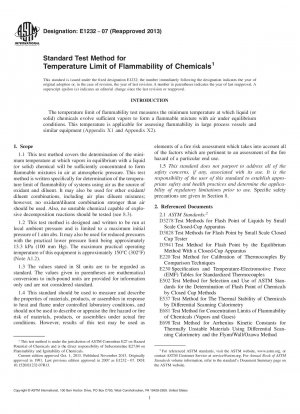ASTM E1232-07(2013)
Standard Test Method for Temperature Limit of Flammability of Chemicals
- Standard No.
- ASTM E1232-07(2013)
- Release Date
- 2007
- Published By
- American Society for Testing and Materials (ASTM)
- Status
- Replace By
- ASTM E1232-07(2019)
- Latest
- ASTM E1232-07(2019)
- Scope
5.1 The lower temperature limit of flammability is the minimum temperature at which a liquid (or solid) chemical will evolve sufficient vapors to form a flammable mixture with air under equilibrium conditions. Knowledge of this temperature is important in determining guidelines for the safe handling of chemicals, particularly in closed process and storage vessels.
Note 1—As a result of physical factors inherent in flash point apparatus and procedures, closed-cup flash point temperatures are not necessarily the minimum temperature at which a chemical will evolve flammable vapors (see Appendix X2 and Appendix X3, taken in part from Test Method E502). The temperature limit of flammability test is designed to supplement limitations inherent in flash point tests (Appendix X2). It yields a result closely approaching the minimum temperature of flammable vapor formation for equilibrium situations in the chemical processing industry such as in closed process and storage vessels.Note 2—As a result of flame quenching effects existing when testing in standard closed-cup flash point apparatus, there are certain chemicals that exhibit no flash point but do evolve vapors that will propagate a flame in vessels of adequate size (X3.2). The temperature limit of flammability test chamber is sufficiently large to overcome flame quenching effects in most cases of practical importance, thus, usually indicating the presence of vapor-phase flammability if it does exist (6.2).Note 3—The lower temperature limit of flammability (LTL) is only one of several characteristics that should be evaluated to determine the safety of a specific material for a specific application. For example, some materials are found to have an LTL by this test method when, in fact, other characteristics such as minimum ignition energy and heat of combustion should also be considered in an overall flammability evaluation.5.2 The vapor concentration present at the lower temperature limit of flammability equals the lower flammable limit concentration as measured by Test Method E681 and extrapolated back to the same temperature. (This permits estimation of lower temperature limits of flammability if vapor pressure and concentration limit of flammability data are available (A2.3). A comparison of results of the tests, thus, affords a check on test reliability, the reliability of vapor pressure data, or both.)
1.1 This test method covers the determination of the minimum temperature at which vapors in equilibrium with a liquid (or solid) chemical will be sufficiently concentrated to form flammable mixtures in air at atmospheric pressure. This test method is written specifically for determination of the temperature limit of flammability of systems using air as the source of oxidant and diluent. It may also be used for other oxidant/diluent combinations, including air plus diluent mixtures; however, no oxidant/diluent combination stronger than air should be used. Also, no unstable chemical capable of explosive decomposition reactions should be tested (see 8.3).
1.2 This test method is designed and writt......
ASTM E1232-07(2013) Referenced Document
- ASTM D3278 Standard Test Methods for Flash Point of Liquids by Small Scale Closed-Cup Apparatus
- ASTM D3828 Standard Test Methods for Flash Point by Small Scale Closed Tester
- ASTM D3941 Standard Test Method for Flash Point by the Equilibrium Method With a Closed-Cup Apparatus
- ASTM E220 Standard Test Method for Calibration of Thermocouples By Comparison Techniques
- ASTM E230 Standard Specification and Temperature-Electromotive Force (EMF) Tables for Standardized Thermocouples
- ASTM E502 Standard Test Method for Selection and Use of ASTM Standards for the Determination of Flash Point of Chemicals by Closed Cup Methods
- ASTM E537 Standard Test Method for Assessing the Thermal Stability of Chemicals By Methods of Thermal Analysis
- ASTM E681 Standard Test Method for Concentration Limits of Flammability of Chemicals (Vapors and Gases)
- ASTM E698 Standard Test Method for Arrhenius Kinetic Constants for Thermally Unstable Materials
ASTM E1232-07(2013) history
- 2019 ASTM E1232-07(2019) Standard Test Method for Temperature Limit of Flammability of Chemicals
- 2007 ASTM E1232-07(2013) Standard Test Method for Temperature Limit of Flammability of Chemicals
- 2007 ASTM E1232-07 Standard Test Method for Temperature Limit of Flammability of Chemicals
- 2002 ASTM E1232-02 Standard Test Method for Temperature Limit of Flammability of Chemicals
- 1991 ASTM E1232-91(1996) Standard Test Method for Temperature Limit of Flammability of Chemicals

Copyright ©2024 All Rights Reserved